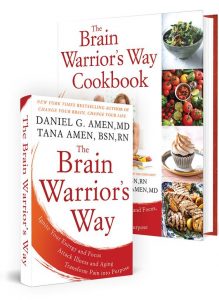How You Can Improve The Function Of Your Cerebellum Right Now, with Mary Schlesinger

Through the use of interactive metronome therapy, Mary Schlesinger has seen terrific outcomes with all kinds of brains, ranging from autism and ADHD. In the final episode of a series with Mary, she and the Amens discuss how you can utilize this type of therapy to improve the health and functioning of your cerebellum, leading to better coordination and faster thinking.
For more information on interactive metronome training, visit https://www.amenclinics.com/services/interactive-metronome-training/
Daniel Amen, MD:
Welcome to the Brain Warrior’s Way podcast. I’m Dr. Daniel. Amen.
Tana Amen, BSN RN:
And I’m Tana Amen. In our podcast, we provide you with the tools you need to become a warrior for the health of your brain and body.
Daniel Amen, MD:
The Brain Warrior’s Way podcast is brought to you by Amen Clinics, where we have been transforming lives for 30 years using tools like brain SPECT imaging to personalize treatment to your brain. For more information, visit amenclinics.com.
Tana Amen, BSN RN:
The Brain Warrior’s Way podcast is also brought to you by BrainMD, where we produce the highest quality nutraceuticals to support the health of your brain and body. To learn more, go to brainmd.com.
Welcome back. We are here in our fourth episode with Mary Schlesinger. She is an interactive metronome therapist, and she’s our Reston clinic, and this has just been interesting hearing about this noninvasive treatment. I’m making many comparisons in my mind. Welcome back, Mary. This has been so interesting hearing the stories about kids being able to make these types of improvements.
Daniel Amen, MD: I mean, we’ve talked about a baby. We’ve talked about kids with ADD and autism. We’ve talked about an elderly couple, your brain, no matter what your age is critically important, and one of the most important parts of the brain that very few people talk about besides us at Amen Clinics is the cerebellum, and how I learned it was important is on SPECT scans, the cerebellum is the most active part of the brain. It’s not true with PAD.
It’s clearly not true with quantitative EEG, but the medicine we use with SPECT goes to the cerebellum, and it is usually the most active part of the brain, which makes complete sense, because it’s 10% of the brain’s volume, but it has half the brain’s neurons, and I think of it as the CPU or the central processing unit in the brain, and when the cerebellum’s hurt, everything is not good, and this is why actually you shouldn’t drink, because drinking shrinks the cerebellum.
Mary, I want you and I to do a study of like 20 consecutive people you work with and we should actually do before and after scans. I know there’s a lot of research published on the cerebellum, and the interactive metronome, but we shouldn’t do our own, but just go through the list of people you’ve seen, what problems they had, and how this has helped them, and the other part about this is there’s virtually no side effects. It’s an investment in time, and a little bit of money. It’s actually not very expensive, but in time, a little bit of money, and the potential benefits for people.
Mary Scheslinger: Right? Right. Yeah. Gosh, where do you even start? I’ve worked with people who have autism, on the autism spectrum and that’s a pretty tough situation, but there again, calming things down, getting them to the point where they’re able to be more directed in the classroom. You get comments coming back from the teachers, things like that, and just to be more stable, more steady, that sort of thing.
I have worked with people who have PTSD. I had the opportunity to work with someone who was caught in a domestic terrorism situation, one of the big ones, and he had basically anger management issues, and just foggy thinking. He had problems learning, and just everything that went with that, it was impacting his personal life and his work life, and he went through the program really, really nice results.
He was able to identify when he was getting angry and then deescalate, and he was able to understand how other people could maybe not want to be around him. You could see where his actions were impacting other people. All of that smoothed out, he regained his confidence and improved his memory and just not feeling apathetic anymore. That was a good one.
Obviously, I talked about ADHD, but so many kids that have ADHD. I’ve had people who like I had one man, his son basically, he was around six years old and they never been able to reach him, and when they did metronome and they had a very, very quick result, he said, “Thank you. You have just for the first time introduced us to our son,” and it just said chills through my body, and it turns out to be just this wonderful little boy and a great kid, and he still has some things that he’s working on, but you know, I hear things like that, and then with older people, sometimes they just want to stay sharp.
I have been giving presentations to retirees and there’s three things in my mind that are important. You want to be able to stay behind the wheel as long as you can do so safely. This has an impact in that area. Obviously, you don’t want to be a fall risk, because we all know what happens. My poor father broke his shoulder, elbow and hip all in one fall, and nobody wants to go down that road, and then you just obviously want to stay brain sharp.
Those are the things that I emphasize when I give the presentations to the 55 plus positive aging type presentations, because those are the things that I want to avoid, and then there’s a lot of seniors who are out gardening and things until they’re bending down and they’re standing on slippery flagstone and things like that and they want to have a good sense of balance and coordination. There’s that. Gosh, People with traumatic brain injury line, just on and on it, it can be really anything.
Daniel Amen, MD: Let’s talk about traumatic brain injury for a minute. There is a very clear dynamic tension between the front part of the brain and the cerebellum, and if you think of the front part of the brain focus, forethought judgment, impulse control, organization, planning, empathy, learning from the mistakes you make, and when you hurt the left or right side, it actually turns off the opposite side cerebellum. Actually at long term for it’s called cross, because it crosses cerebellar diastasis, diastasis just meaning low activity, low blood flow, and we find activating the cerebellum actually helps the front part of the brain work better.
If you damage the left or right front part of your brain in a fall, in a car accident, in a domestic violence situation, part of rehabilitating that is also rehabilitating the cerebellum, and this is where the interactive metronome can be really helpful for someone. Just think of it as rebalancing your brain. When the cerebellum is low, people tend to have coordination problems, but also thought coordination problems, how quickly you can integrate new information, and processing speed likely goes up as well.
Tana Amen, BSN RN: Yeah. That’s super interesting.
Mary Scheslinger: Right? Well, they did some research on that, and I actually had the title of the research. This was a journal of neuropsychology, and the title is effective interactive metronome therapy on cognitive function after blast related brain injury. Dr. Lonnie Nelson, and Doctors, McDonald’s [inaudible [00:08:45], and they took 50 combat vets, and these were all veterans that were two and a half years post injury, and they took them through a metronome and some traditional training, and the other group was just the traditional training and they found that in 21 of 26 areas.
They had significant improvement, and some of the areas included processing speed. I think you mentioned attention, and memory, and things like that. That was a very nice piece of research, and in my mind, if you have a traumatic brain injury of blast injury, because you’re our combat vet, it’s not unlikely that you wouldn’t have a PTSD situation as well. That’s just a nice piece of research that I think would be important for veterans to take a look at.
Daniel Amen, MD: That’d be great. Well, we have to stop, but we’re so grateful for the work you do at our Reston clinic, which is right outside of Washington DC, and what did you learn during the series of podcasts with Mary? What’s the one thing? Post that on any of your social media channels, and then leave it at the brainwarriorswaypodcast.com.
Also leave us a comment question or a review, and we’ll enter you into a drawing to get Tana’s book, the Brain Warrior’s Way Cookbook or my new book, The End of Mental Illness. Mary we’re just so grateful for your work and your time.
Tana Amen, BSN RN: Thanks, Mary.
If you’re enjoying the Brain Warrior’s Way Podcast, please don’t forget to subscribe, so you’ll always know when there’s a new episode and while you’re at it, feel free to give us a review or five star rating, as that helps others find the podcast.
Daniel Amen, MD: If you’re considering coming to Amen Clinics or trying some of the brain healthy supplements from BrainMD, you can use the code podcast 10 to get a 10% discount on a full evaluation at amenclinics.com or a 10% discount on all supplements at brainmdhealth.com. For more information, give us a call at 855-978-1363.

